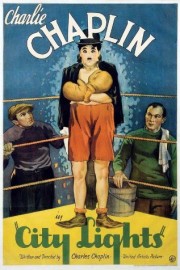City Lights
“City Lights” is, above all, a study in perception. The way people see Charlie Chaplin’s Little Tramp in this film is essential to its success; well, that and the romantic soul at the center of it all between the Tramp and the Blind Flower Girl (who is not given a proper name), culminating in one of the great, romantic and emotional moments in film history.
The Little Tramp is a simple man; certainly not a wealthy man, he nonetheless has accepted life on its own terms, and treats everyone he meets with respect, even if it isn’t reciprocated– most people only see a bum. The only ones who treat the Tramp with kindness are: the Flower Girl, who cannot see his physical appearance, but sees his giving nature; and a millionaire, whom the Tramp saved from committing suicide one, drunken night. Unfortunately, it’s only while drunk when the millionaire appreciates the Tramp’s company; once he sobers up the next morning, he doesn’t remember the good times the pair had the night before.
The movie begins with a joke. After the credits, we find ourselves at the unveiling of a statue in the town square. The mayor and other dignitaries are speaking, but rather than hearing their voices, we hear what sound like kazoos. (Perhaps a precursor to the adults in Peanuts cartoons to come?) Even though it’s amusing on its own, some historical context is important to understanding Chaplin’s point. At the time of its release in 1931, movies had been integrated to include sound and dialogue for about four years. That right there is enough to let you in on the joke– Chaplin was taking a dig at talkies. That said, he couldn’t resist sound forever, and indeed, “City Lights” was his final silent film; in 1936, dialogue was spoken in his “Modern Times,” although the Tramp remained forever silent, before taking over completely in his 1940 satire, “The Great Dictator.” However, Chaplin, like that other master of silent comedy, Buster Keaton, had a hard time making the transition to sound films; even more so than Keaton’s, Chaplin’s sensibilities were steeped in the old, vaudeville traditions of making people laugh, and at least in the early years of the talkies, that philosophy didn’t really carry over, especially since the Tramp was a character more of action than words.
I don’t mean to make Chaplin’s films seem hopelessly dated, however. Despite their being rooted in early 20th century ideas of comedy, the writer/director/star’s best films remain a wonderful moviewatching experience. “City Lights” trumps them all, with its sweet and hopeful central romance between the Tramp and the Flower Girl; the vaudeville slapstick of the Tramp’s misadventures with the millionaire; the boxing match, in which the Tramp tries to earn money for the Flower Girl for eye surgery; and finally, that final scene, where the Tramp and Flower Girl see each other. for the first time, as they truly are. Music swells. The End. Anybody have a kleenex?










